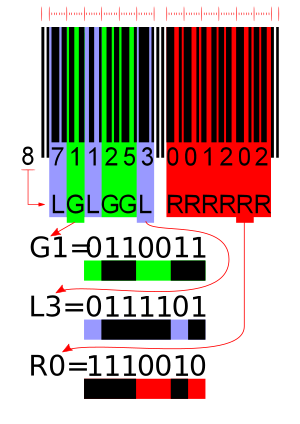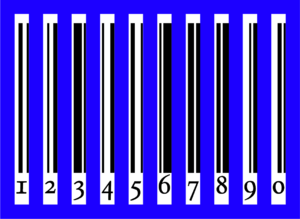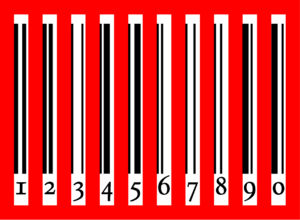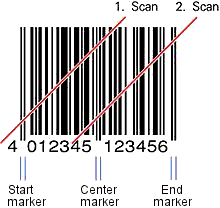International Article Number facts for kids
The International Article Number (also known as EAN) is a special code used all over the world to identify products. Think of it like a unique ID card for items you buy in a store, like a box of cereal or a new toy. This code is usually found in a barcode, which is a pattern of black lines and white spaces that a scanner can read.
The EAN system helps stores keep track of products, manage their inventory, and make sure you get the right price at the checkout. These barcodes only use numbers from 0 to 9.
The most common EAN code is the 13-digit EAN-13. It's like an updated version of the 12-digit Universal Product Code (UPC-A) used in North America. An EAN-13 number starts with a 3-digit GS1 prefix, which usually tells you which country or organization registered the product. If an EAN-13 code starts with "0," it's actually a UPC-A code. Some EAN codes starting with "45" or "49" are called Japanese Article Numbers (JAN).
For smaller items, there's an 8-digit EAN-8 barcode. There are also smaller 2-digit EAN-2 and 5-digit EAN-5 barcodes. These are often used on magazines to show the issue number or on food items to show the suggested price.
Contents
What's Inside an EAN Number?
A 13-digit EAN-13 number has four main parts:
- GS1 prefix – 3 digits
- Manufacturer code – a different length for each company
- Product code – a different length for each product
- Check digit – a special number to catch errors
GS1 Prefix
The first three digits of an EAN-13 code are called the GS1 Prefix. This usually tells you which GS1 organization (a global group that manages these codes) the manufacturer belongs to. It doesn't always mean the product was made in that country. For example, many products sold outside the US and Canada might have EAN-13 codes starting with "0" because they were registered through GS1-US.
Some special prefixes exist. For instance, codes starting with "020" to "029" are often used by stores for their own brands or for items they package themselves, like fresh produce. These barcodes might even include the price or weight of the item.
The EAN prefixes "978" and "979" are special for books. This system is sometimes called "Bookland." It means that books use EAN codes that are also their ISBN (International Standard Book Number). The prefix "979" with a first digit "0" is for music (ISMN), and "977" is for magazines and newspapers (ISSN).
Manufacturer Code
The manufacturer code is a unique number given to each company by the GS1 organization. All products from the same company will share this code. EAN-13 uses "variable-length" manufacturer codes. This means if a company only makes a few products, they might get a longer manufacturer code. This helps use the available numbers more efficiently, so we don't run out of codes too quickly.
Product Code
The manufacturer assigns the product code to each specific item they sell. This code comes right after the manufacturer code. The total length of the manufacturer code plus the product code is usually 9 or 10 digits.
For books, music, and magazines, this part of the code uniquely identifies the specific publication from that publisher.
Check Digit
The check digit is the very last digit in an EAN code. It's like a secret math trick used to make sure the barcode was scanned correctly. If a scanner reads the code, it does a quick calculation using the other digits. If the result matches the check digit, it knows the scan was accurate. This helps catch mistakes, like if a scanner misreads one of the numbers.
How is the Check Digit Calculated?
The check digit is calculated using a simple math rule. You multiply each digit in the barcode (except the last one) by either 3 or 1, alternating as you go from right to left.
Here's how the weights work for different EAN codes:
| position | 17 | 16 | 15 | 14 | 13 | 12 | 11 | 10 | 9 | 8 | 7 | 6 | 5 | 4 | 3 | 2 | 1 |
|---|---|---|---|---|---|---|---|---|---|---|---|---|---|---|---|---|---|
| weight | 3 | 1 | 3 | 1 | 3 | 1 | 3 | 1 | 3 | 1 | 3 | 1 | 3 | 1 | 3 | 1 | 3 |
Weights for EAN-13 code:
| position | 12 | 11 | 10 | 9 | 8 | 7 | 6 | 5 | 4 | 3 | 2 | 1 |
|---|---|---|---|---|---|---|---|---|---|---|---|---|
| weight | 1 | 3 | 1 | 3 | 1 | 3 | 1 | 3 | 1 | 3 | 1 | 3 |
Weights for EAN-8 code:
| position | 7 | 6 | 5 | 4 | 3 | 2 | 1 |
|---|---|---|---|---|---|---|---|
| weight | 3 | 1 | 3 | 1 | 3 | 1 | 3 |
Calculation Examples
- For an EAN-13 barcode like 400638133393x, where x is the missing check digit:
| position | 12 | 11 | 10 | 9 | 8 | 7 | 6 | 5 | 4 | 3 | 2 | 1 |
|---|---|---|---|---|---|---|---|---|---|---|---|---|
| first 12 digits of barcode | 4 | 0 | 0 | 6 | 3 | 8 | 1 | 3 | 3 | 3 | 9 | 3 |
| weight | 1 | 3 | 1 | 3 | 1 | 3 | 1 | 3 | 1 | 3 | 1 | 3 |
| partial sum | 4 | 0 | 0 | 18 | 3 | 24 | 1 | 9 | 3 | 9 | 9 | 9 |
| checksum | 89 |
The sum is 89. To get to the next number divisible by 10 (which is 90), you need to add 1. So, the check digit x is 1.
- For an EAN-8 barcode like 7351353x, where x is the missing check digit:
| position | 7 | 6 | 5 | 4 | 3 | 2 | 1 |
|---|---|---|---|---|---|---|---|
| first 7 digits of barcode | 7 | 3 | 5 | 1 | 3 | 5 | 3 |
| weight | 3 | 1 | 3 | 1 | 3 | 1 | 3 |
| partial sum | 21 | 3 | 15 | 1 | 9 | 5 | 9 |
| checksum | 63 |
The sum is 63. To get to the next number divisible by 10 (which is 70), you need to add 7. So, the check digit x is 7.
How Barcodes Are Made (Encoding)
EAN barcodes are made of 95 tiny sections, either black or white. These sections form the bars and spaces you see.
The barcode has:
- A start marker (three sections: black-white-black).
- Sections for the first six digits.
- A center marker (five sections: white-black-white-black-white).
- Sections for the last six digits.
- An end marker (three sections: black-white-black).
How Digits Become Bars
To create the EAN-13 barcode, the 13 digits are split into three groups: the first digit, the first group of six digits, and the last group of six digits.
The first digit isn't directly shown as bars. Instead, it tells the scanner how to read the first six digits by choosing different patterns of black and white bars for them. The last six digits always use the same pattern.
If the first digit is zero, the barcode uses the same pattern as a UPC barcode. This means a UPC barcode is also a type of EAN-13 barcode!
| First digit | First group of 6 digits | Last group of 6 digits |
|---|---|---|
0 |
LLLLLL |
RRRRRR |
1 |
LLGLGG |
RRRRRR |
2 |
LLGGLG |
RRRRRR |
3 |
LLGGGL |
RRRRRR |
4 |
LGLLGG |
RRRRRR |
5 |
LGGLLG |
RRRRRR |
6 |
LGGGLL |
RRRRRR |
7 |
LGLGLG |
RRRRRR |
8 |
LGLGGL |
RRRRRR |
9 |
LGGLGL |
RRRRRR |
This special way of encoding helps scanners read the barcode correctly, no matter if they scan it from the left or the right.
EAN-8 barcodes are simpler; they just use two groups of four digits:
| First group of 4 digits | Last group of 4 digits |
|---|---|
LLLL |
RRRR |
Each digit is made up of two black bars and two white spaces. The width of these bars and spaces can vary.
EAN-13 Barcode Example
- C1, C3: These are the start and end markers.
- C2: This is the marker in the middle of the barcode.
- The left side has 6 digits: 003994.
- The right side has 6 digits (the last one is the check digit): 155486.
- Each digit is encoded using seven tiny sections, forming two black bars and two white spaces.
- The first digit of the EAN code (in this example, 4) is hidden in the way the first six digits are encoded.
So, the full EAN-13 code shown is 4 003994 155486.
How Scanners Read Barcodes
Barcode scanners can often read just one half of the barcode at a time because of the center marker. This allows them to piece together the full code, even if they scan it at an angle.
Japanese Article Number
The Japanese Article Number (JAN) is a barcode standard used in Japan that works just like the EAN system. It started in 1978. JAN codes originally began with "49," and later "45" was added. Since 2001, new companies in Japan get longer manufacturer codes.
See also
 In Spanish: European Article Number para niños
In Spanish: European Article Number para niños
- EAN-8, another type of EAN barcode
- EAN-5, an extra EAN code for things like suggested prices
- GTIN







